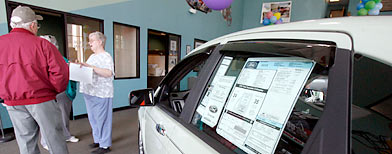 Successfully negotiating the price of a new car isn't a deep, dark mystery.
Successfully negotiating the price of a new car isn't a deep, dark mystery.In a dealership experience that by design confuses and wears down car buyers, getting the lowest price on a new car requires research, commitment, patience and the right attitude.
What is the right attitude? According to Philip Reed, Edmunds.com senior consumer advice editor, negotiating doesn't have to be an all-out war. It should be a business negotiation. "It can be done honorably and honestly," he says.
But consumers who don't regularly negotiate may find the thought of matching wits with a professional negotiator to get the best new-car price more than a little intimidating. However, nothing levels the negotiating playing field like knowledge born through research.
Knowing the manufacturer's suggested retail price, or MSRP, is the initial step in researching price. However, if your intention is to negotiate a lower price, an estimate of the dealer's actual cost can be valuable in establishing an opening offer for your negotiations. According to Reed, the factors contributing to dealer cost include:
• Dealer Invoice. The price the manufacturer charges the dealer for a car. Reed says before negotiations begin, ask the dealer to show you the actual invoice. Through your online research, you should already have a sound idea of what the dealer paid for the vehicle, but the invoice will also tell you how long the vehicle has been on the lot. "If it's been on the lot for a month or more, they will be eager to get rid of it," he says.
• Dealer Cash Incentives. Manufacturers often provide the dealers with temporary cash incentives to sell specific car models. These are dollars the customer never sees and often doesn't know about without digging into the research.
• Destination Fee. The amount the manufacturer charges the dealer to deliver the vehicle to the dealership. It is itemized on the MSRP.
• Regional Advertising Fees. These are the costs of advertising the car in the dealer's market.
• Dealer Holdback. This is a percentage of the MSRP that the manufacturer sometimes reimburses to the dealer at some point after the consumer has taken delivery. Something like profit sharing, it is cash the dealer receives over and above profit generated from the transaction price.
Reed recommends that you decide what you want to pay for the car and then begin negotiations at a number below that, moving up from there, "adding $500 or so to make them think they are making progress as you move toward the price you have in mind," he says.
Here are Reed's negotiating tips:
• Shop around and play dealers off of one another.
• Don't try to negotiate when the dealership is busy, like on Saturdays.
• Line up your car financing before going to the dealership so you are a cash customer and can avoid any dealer's attempt to negotiate the monthly payment.
• Be prepared to walk out if you don't get the price you want.
Websites like Edmunds.com, TrueCar.com and KBB.com (Kelley Blue Book) not only provide the MSRP and dealer invoice price for cars, they also compute the real-world average transaction price. But a successful negotiation will put the final transaction price on the car somewhere between the dealer's invoice and MSRP.
"The invoice price and the sticker price define the low and high end of the pricing scale," Reed says. "You want to wind up somewhere in between."
No comments:
Post a Comment